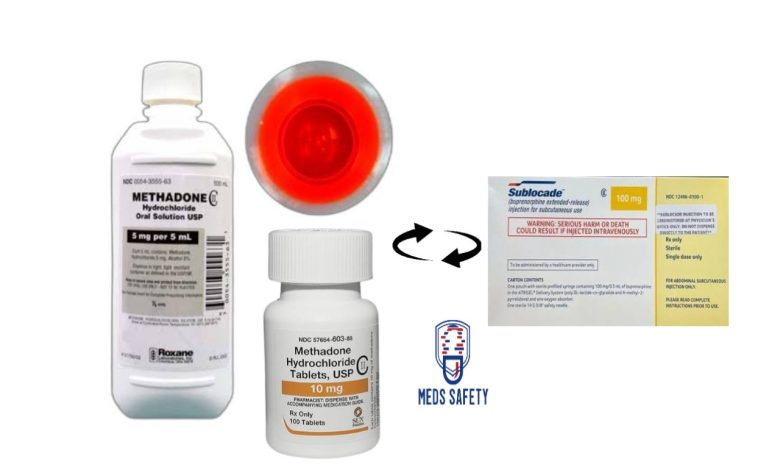Can You Switch From Methadone To Sublocade?

In the realm of medication-assisted treatment (MAT) for opioid addiction, individuals may explore different options to optimize their recovery journey. Methadone and Sublocade are two medications commonly used in MAT programs. Methadone has been a long-standing treatment option, while Sublocade is a relatively newer addition to the field.
MAT programs are comprehensive approaches to addressing substance use disorders, particularly opioid addiction. MAT combines the use of medications, such as Methadone and Sublocade with counseling, therapy, and other support services. These programs have been shown to be effective in reducing opioid use, preventing relapse, and supporting long-term recovery. Here are some key points about MAT programs:
This article aims to provide a comprehensive exploration of the topic of switching from methadone to Sublocade, shedding light on the process, considerations, and potential benefits and challenges associated with the transition.
Understanding Methadone and Sublocade
Methadone is an opioid agonist medication that has been utilized for decades in MAT programs. It works by binding to the same receptors in the brain as other opioids, reducing withdrawal symptoms and cravings while minimizing the euphoric effects of illicit opioids.
Sublocade, on the other hand, is a newer medication in the form of a monthly extended-release buprenorphine injection. Buprenorphine is a partial opioid agonist that works similarly to methadone, reducing withdrawal symptoms and cravings. Sublocade offers the advantage of providing a continuous release of medication over an extended period, eliminating the need for daily dosing.

Can You Switch From Methadone To Sublocade?
Yes, it is possible to switch from methadone to Sublocade, but it should be done under the guidance and supervision of a healthcare professional experienced in addiction medicine.
Switching from methadone to requires an individualized approach. Here are key points to understand about the transition process:
1. Evaluation and Assessment: Before considering a switch, it is crucial to undergo a thorough evaluation by a healthcare professional experienced in addiction medicine. The evaluation will assess factors such as treatment history, stability on methadone, overall health, and individual goals.
2. Dosing and Tapering: A gradual and personalized tapering process is typically necessary when transitioning from methadone to Sublocade. The dosage of methadone is gradually reduced over time while monitoring the individual’s response and withdrawal symptoms. The tapering process ensures a smooth transition and minimizes the risk of withdrawal or discomfort.
3. Stabilization on Sublocade: Once the individual has successfully tapered off methadone, they can start the induction phase with Sublocade. This involves the administration of the initial Sublocade injection, followed by subsequent monthly injections. Close monitoring and support from healthcare professionals are vital during this stabilization phase to ensure adequate dosing and address any challenges that may arise.
Considerations and Challenges
1. Suitability and Individual Response: Not everyone transitioning from methadone to Sublocade will have the same experience. The suitability and effectiveness of Sublocade may vary among individuals. Some individuals may find Sublocade to be a beneficial alternative, while others may require different treatment options.
2. Adjustment Period and Side Effects: As with any medication change, transitioning to Sublocade may involve an adjustment period. Individuals may experience side effects such as injection site reactions, digestive issues, or mild withdrawal symptoms during the stabilization phase. Healthcare professionals will closely monitor these effects and provide the necessary support.
3. Comprehensive Care and Support: Switching from methadone to Sublocade should be part of a comprehensive treatment plan that includes counseling, therapy, and psychosocial support. These services contribute to addressing the underlying causes of addiction, building coping skills, and supporting overall recovery.
Pros and Cons of Methadone and Sublocade
Methadone and Sublocade both have their individual advantages and disadvantages. Here are some pros and cons of both Methadone and Sublocade:
Methadone
Pros:
1. Effectiveness: Methadone has been widely used for decades and has shown effectiveness in reducing withdrawal symptoms and cravings associated with opioid addiction.
2. Long-acting: Methadone’s long duration of action allows for once-daily dosing, providing stable opioid receptor coverage throughout the day.
3. Clinic-based support: Methadone is typically dispensed in specialized clinics, which often offer comprehensive support services such as counseling, therapy, and social support.
Cons:
1. Daily Visits: Initially, methadone treatment requires daily visits to a clinic for medication administration, which may be inconvenient for some individuals.
2. Potential Side Effects: Methadone can cause side effects, including drowsiness, constipation, sweating, and weight gain. These side effects vary among individuals and may affect treatment adherence.
3. Potential for Dependency: While methadone helps manage addiction, it is itself an opioid and can lead to physical dependence. Tapering off methadone may be challenging for some individuals.
Sublocade
Pros:
1. Extended-release formulation: Sublocade is administered as a monthly injection, eliminating the need for daily dosing. This may improve convenience and reduce the risk of missed doses.
2. Lower risk of diversion: Sublocade’s injection formulation reduces the risk of diversion or misuse compared to oral medications.
3. Privacy and Independence: Sublocade allows individuals to have more privacy and independence as they don’t need to visit a clinic daily for medication administration.
Cons:
1. Limited availability: Sublocade may not be as widely available as methadone, depending on the region or healthcare provider. Access to Sublocade could be a limitation for some individuals.
2. Injection site reactions: Some individuals may experience injection site reactions, such as pain, itching, or redness, which can be temporary but may require medical attention.
3. Compliance and Adjustment: Once Sublocade is administered, the medication cannot be easily adjusted or stopped. Some individuals may find it challenging to adjust to the monthly injection and may prefer more flexibility in dosing.
It’s important to note that the pros and cons may vary depending on individual circumstances and preferences. Individual preferences regarding Methadone and Sublocade can vary based on personal experiences, treatment goals, and specific needs. Some individuals may prefer one medication over the other for various reasons. However, it is essential to note that the preference for a specific medication can be subjective and influenced by factors such as convenience, effectiveness, and individual response.
The choice between Methadone and Sublocade should be made in consultation with a healthcare professional who can consider the individual’s specific needs, medical history, and treatment goals. Additionally, considering the availability of these medications in your specific region is crucial.
Conclusion
Switching from methadone to Sublocade is a significant decision that should be made in consultation with qualified healthcare professionals. The transition process requires careful evaluation, individualized tapering, and ongoing support during the stabilization phase. While Sublocade offers advantages such as monthly injections and improved





